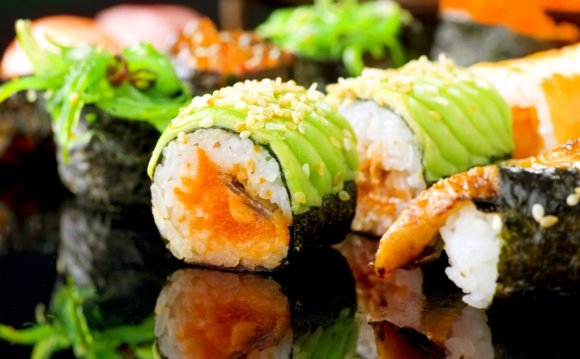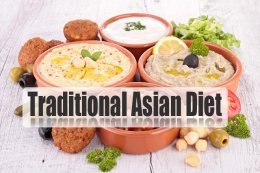
 When we talk about some of the healthiest diets, traditional Asian diet is definitely placed high on the list. It is the perfect example of a well balanced diet that provides all the essential nutrients needed by the body. It is high in vitamins, minerals, fiber and antioxidants and low in saturated fat. It mostly incorporates vegetables, fruits, nuts and legumes and is low in meat and dairy products. This diet follows the dietary principles of historical diets of rural China, Japan and other Asian countries. It is suitable for an average healthy adult while others like pregnant women, children and those with medical issues should consult their physician before resorting to this diet.
When we talk about some of the healthiest diets, traditional Asian diet is definitely placed high on the list. It is the perfect example of a well balanced diet that provides all the essential nutrients needed by the body. It is high in vitamins, minerals, fiber and antioxidants and low in saturated fat. It mostly incorporates vegetables, fruits, nuts and legumes and is low in meat and dairy products. This diet follows the dietary principles of historical diets of rural China, Japan and other Asian countries. It is suitable for an average healthy adult while others like pregnant women, children and those with medical issues should consult their physician before resorting to this diet.
The Theory:
In fact, research has proven that Asians who mostly follow this diet are slimmer and healthier in comparison to their American counterparts who mostly suffer from obesity.The Aim:
The main aim of this diet is to minimize the risk of many chronic diseases such as diabetes, heart disease and certain cancers.
How Does it Work?
As we all know, Asia is a huge continent and so there cannot be a single traditional Asian diet. A traditional Asian diet pyramid has been prepared which recommends a daily consumption of rice, noodles, corn, millets, bread and other whole grains along with fruits, vegetables, nuts, seeds, legumes and vegetable oils. The optional foods include fish and shellfish, eggs, poultry and dairy, which can be taken once a week. Consumption of red meat is restricted to once a month. This diet also advises you to have at least 6 glasses of water in a day. Beer and wine can be taken in moderation. The traditional Asian Diet is based on the following premises.
1. Restriction on Fluid Intake with Meals:
Intake of water or any other drink, especially cold drinks with meals should be avoided. This will prevent the dilution of your digestive enzymes, thus enabling proper digestion. It is advisable to have green tea or other hot teas before a meal as they support enzymatic activities which further enhance your digestive abilities. You can have liquids 30 minutes before or after meals but not in the course of a meal.
2. Ratio of Vegetables to Meat:
The traditional Asian diet chart combines vegetables and meat in the ratio of 3:1. It particularly limits the consumption of meat and potatoes. You can consider taking sweet potatoes if you can’t do without starchy vegetables. Include more of bitter tasting vegetables in your diet. Radish, radichhio and bitter melon should find a place on your plate.
3. Avoid Desserts at Night:
Desserts like sugary cakes, ice cream and cookies should be avoided at night. You can replace them with fruits which are nutritious and delicious. You can also prepare desserts from fruits at home.
4. Consumption of Rice Combinations:
Rice combinations like white, brown, black, red or even purple rice are nutritionally denser than one particular type of rice. In Asia, rice is taken as a supplement to meals, not as a main course. Moreover, unlike other diets, the traditional Asian diet gives more importance to white rice rather than brown rice. Though brown rice is considered more nutritious as its shell is rich in nutrients, it is comparatively difficult for your body to digest those shells. Thus, your body requires a lot of energy to digest brown rice and the process is comparatively lengthier as it slows down your metabolism. Hence, it is advisable to consume both brown and white rice in moderation. It should also be kept in mind that being a carbohydrate, rice is converted into sugar during the digestive process which can cause a dramatic effect in your Glycemic index. Diabetics and pre-diabetics should restrict its consumption to prevent blood sugar fluctuations. Rice combinations, being less starchy, involve lesser sugar conversion and are lower in calories.
5. Consumption of Cooked Vegetables:
This diet advises consuming cooked vegetables rather than raw vegetables. It is true that cooking spoils many nutrients in the vegetables but not cooking them adversely affects your metabolism.
6. Consumption of Calories through Natural Foods:
Research has shown that Asians consume 25 to 40% more calories than Americans, yet they are comparatively healthier and slimmer. The main reason behind this is that these calories are consumed through natural foods and do not cause much harm to the body. It is also comparatively easier to digest than the junk foods and unhealthy processed snacks.
7. Elimination of Cow’s Milk and Milk Combinations
The traditional Asian Diet completely eliminates the consumption of cow’s milk. Besides, milk can combine with almost anything, thus supplying excess calcium and not enough magnesium. Combining the dairy foods drastically slows down your gut motility which adversely affects your digestion. Instead, you can go for coconut, almond, rice or organic soy milk.
INTERESTING VIDEO












